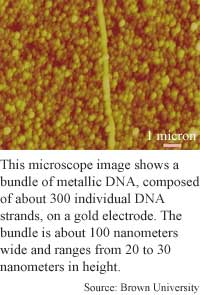
Metal
makes DNA more conductive
By
Chhavi Sachdev,
Technology Research NewsFor several years, scientists have explored ways to make DNA conduct electricity. DNA’s size and ability to arrange itself, or self-assemble, would make conductive DNA a valuable material for nanoscale circuitry.
One group of researchers has replaced parts of DNA’s base pairs with metal ions in order to allow electrons to flow through the molecule.
Biological DNA, found in the nucleus of every cell, is essentially composed of long strands of four bases -- adenine, guanine, cytosine, and thymine. The researchers engineered the conductive DNA by coaxing the base pairs to exchange a proton for a zinc ion. The addition of metal made DNA behave like a semiconductor.
“The substitution of the imino proton with a zinc ion makes the DNA hundreds of times more conductive,” said researcher Jimmy Xu, an engineering and physics professor at Brown University.
The engineered DNA could eventually be used in microelectronics where there is a need for tiny, self-assembling conductors. The DNA could be the basis for “a new material system that can be controllably produced, whose properties can be…engineered, and whose ensemble can self-organize into functional structures and can collectively process massive amount of information,” said Xu.
“DNA is the basic and best understood building block -- a perfect place to start engineering,” he said.
Engineering DNA molecules to accept the zinc was relatively simple, according to Xu. Previous research by team member Jeremy Lee, a biochemistry professor at the University of Saskatchewan, had already established that DNA readily absorbs ions of zinc, nickel and cobalt at high pH levels.
Xu’s team raised the DNA’s pH level to 9.0 by adding zinc ions containing acids to a test tube of DNA. The DNA molecules released the imino protons in their base pairs and took up zinc ions instead, resulting in a modified, metallic compound DNA , or M-DNA.
The conductivity of any substance depends on the placement and number of electrons in its energy bands. The wider the energy bands of a molecule, the faster the electrons move; the faster the movement of electrons, the better the conductivity. Metals generally have wider bands than semiconductors, which have wider bands than insulators.
Biological DNA shows a band-gap of a few hundred millielectron volts at room temperature, according to the researchers. This gap is an energy barrier that any electron coming from the electrode would have to overcome before it could be conducted up the molecule, said Xu.
In contrast, M-DNA's “conduction band is wide and low enough in energy that the electrons from the electrode can move into [it] without difficulty,” said Xu.
This difference makes metallic DNA an ideal nanoscale semiconductor, according to Xu.
“With semiconductors you have a set of base materials - building blocks - which can be turned into a vast array of useful devices and sensors, which, in turn, can be connected up to form circuits, processors, and computers,” Xu said. The engineered DNA is a new material, “and new materials are technology enablers,” he said.
Metallic DNA could also be used as a biosensor to screen, among other things, genetic aberrations and environmental toxins. Metallic DNA could be used in sensors in 3 to 5 years, Xu said.
“It is interesting work, but I think there still needs to be a lot done to structurally characterize this system,” said Jacqueline K. Barton, a professor of chemistry at the California Institute of Technology.
It’s the first time zinc has been studied in this way, said Mark Ratner, a professor of chemistry at Northwestern University. The work is “an intriguing and important contribution,” but the other research in the field of conductive DNA has produced different results. “There is lots yet to be done,” he said.
Other researchers are more skeptical about the findings. “[Xu and his colleagues] find a very low gap even for simple [biological] DNA, which contrasts [with] similar measurements by us and others where we find true insulating behavior at these length scales,” said Cees Dekker, a professor of physics at the Delft University of Technology in the Netherlands.
Xu’s research colleagues were Andrei Rakitin, Chris Papadopoulos, and Yuri Kobzar of Brown University; Palok Aich and Jeremy S. Lee of the University of Saskatchewan; and Alex S.Vedeneev of the Russian Academy of Sciences. Their paper appeared in the journal Physical Review Letters, April 16, 2001.
The research was funded in part by the Canadian Institute for Advanced Research, the National Sciences and Engineering Council of Canada, Motorola, the Defense Advanced Research Projects Agency (DARPA), the Office of Naval Research, the National Science Foundation, and the Air Force Office of Scientific Research.
Timeline: 3 - 5 years
Funding: Government; Corporate
TRN Categories: Biological, Chemical, DNA and Molecular Computing
Story Type: News
Related Elements: Technical paper, " Metallic Conduction through Engineered DNA: DNA Nanoelectric Building Blocks" appeared in the journal Physical Review Letters, April 16, 2001.
Advertisements:
May 2/9, 2001
Page One
Jolts yield nanotube transistors
Simulation hints at quantum computer power
Metal makes DNA more conductive
Etching process points to nanotech production
Plastic pins DNA molecules in place

News:
Research News Roundup
Research Watch blog
Features:
View from the High Ground Q&A
How It Works
RSS Feeds:
News
Ad links:
Buy an ad link
| Advertisements:
|
 |
Ad links: Clear History
Buy an ad link
|
TRN
Newswire and Headline Feeds for Web sites
|
© Copyright Technology Research News, LLC 2000-2006. All rights reserved.